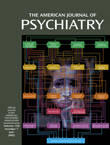Implications for Altered Glutamate and GABA Metabolism in the Dorsolateral Prefrontal Cortex of Aged Schizophrenic Patients
Abstract
OBJECTIVE: Pharmacological, clinical, and postmortem studies suggest altered γ-aminobutyric acid (GABA)-ergic and glutamatergic function in patients with schizophrenia. The dorsolateral prefrontal cortex is one key locus of abnormality. The precise neurochemical mechanisms underlying neurotransmitter alterations, such as hypoglutamatergia or GABA dysfunction, are not well understood. This study investigated key biochemical elements of GABA and glutamate metabolism in brain specimens from schizophrenic patients. The activities of nine principal GABA and glutamate-associated metabolic enzymes were measured concurrently in the dorsolateral prefrontal cortex of antemortem-assessed and neuropathologically characterized schizophrenic and comparison subjects. METHOD: Postmortem dorsolateral prefrontal cortex specimens from schizophrenia, Alzheimer’s disease, and normal nonpsychiatric comparison subjects were assayed to determine activities of the principal glutamate and GABA-metabolizing enzymes glutamine synthetase, glutamate dehydrogenase, α-ketoglutarate dehydrogenase, phosphate-activated glutaminase, alanine aminotransferase, aspartate aminotransferase, glutamic acid decarboxylase, GABA-transaminase, and succinic semialdehyde dehydrogenase. RESULTS: Glutamic acid decarboxylase activities were twofold greater and phosphate-activated glutaminase activities were fourfold greater in the schizophrenic group than in the comparison group. Differences in postmortem interval, tissue pH, inhibition of phosphate-activated glutaminase, and medication effects could not account for the differences. Differences in phosphate-activated glutaminase and glutamic acid decarboxylase activities in equivalent specimens from Alzheimer’s patients were not observed. The activities of the remaining enzymes were unchanged. CONCLUSIONS: Greater phosphate-activated glutaminase and glutamic acid decarboxylase activities, specific to schizophrenia patients, provide additional biochemical evidence that dorsolateral prefrontal cortex glutamate and GABA metabolism is altered in schizophrenic subjects. These greater activities are consistent with models of a dysregulated glutamatergic/GABA-ergic state in schizophrenia.



